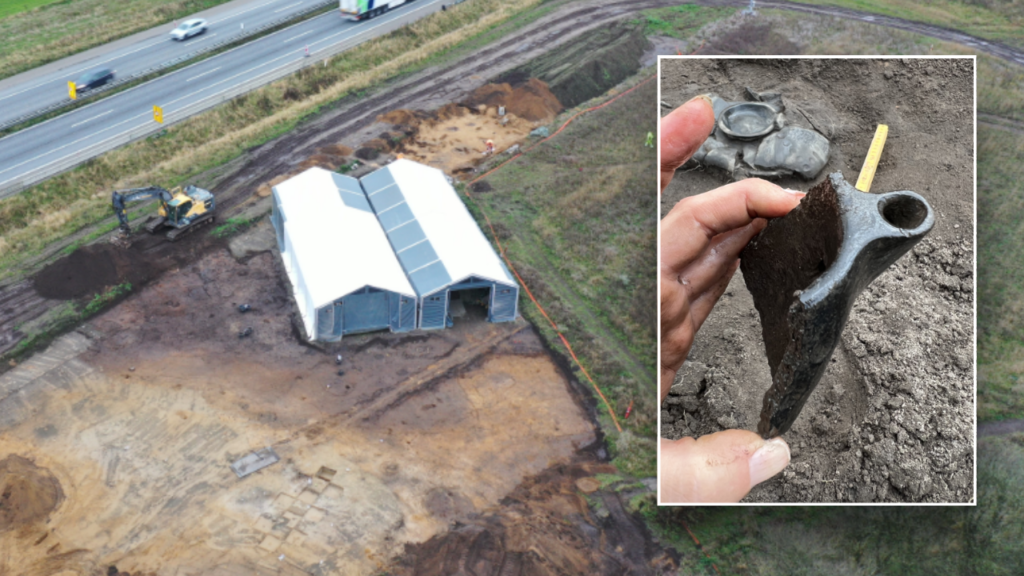Recent archaeological excavations in Denmark have yielded an unexpected discovery: an ancient Roman helmet. This fascinating find was unearthed by experts from Vejle Museums during a digging operation in the village of Løsning, which took place in the fall of 2023. In a press release published on January 29, 2024, the museum detailed the significant archaeological artifacts uncovered during this excavation, highlighting the Roman armor as a central figure in this intriguing narrative.
Initially, the archaeologists did not recognize the significance of two unusual iron plates they encountered during the dig. The Vejle Museums noted, “At first glance, it was unclear what these plates had belonged to.” This uncertainty led them to utilize modern technology, specifically X-ray imaging, which allowed conservators and archaeologists to peer beneath the thick layers of rust enveloping the objects. The imaging revealed a remarkable find: the remains of a Roman helmet.
This discovery is particularly noteworthy, as it marks the first instance of an ancient Roman helmet being found in Denmark. According to the press release, the two plates consist of a neck guard and a decorated cheek guard from what is known as a crest helmet—a design that was commonly used in the Roman Empire during the 4th century. Archaeologists highlighted the rarity of such finds, stating, “Roman helmet finds from the Iron Age are exceptionally rare in southern Scandinavia, and there are no direct parallels to this discovery.”
Alongside the Roman artifacts, the excavation site revealed numerous weapons and pieces of armor from the Iron Age. One particularly significant find was an intricately designed chainmail shirt, which experts believe may have belonged to a chieftain. The manner in which these war equipment pieces were buried suggests they were not mere leftovers, but rather part of a ceremonial offering to higher powers, as noted in the museum’s release.
Additionally, the excavation team discovered fragments of bronze neck rings, or “oath rings.” These artifacts held considerable significance, symbolizing power, status, and influence in ancient societies. The statement from Vejle Museums emphasizes the rarity of chainmail shirts from the Iron Age found in southern Scandinavia. Remarkably, the chainmail that was discovered at Løsning Søndermark stands out as it was uncovered in relation to a settlement, not in a traditional burial or bog setting.
Creating chainmail required not only skill but also access to resources and efforts spanning a significant amount of time. As such, these costly armors were typically owned by the elite warrior class within the community. Given this context, the burial of such valuable equipment suggests a deeper cultural importance and likely connections to social hierarchies of the time.
Archaeologists plan to further analyze the deposits surrounding where the weapons were interred. This examination aims to uncover any potential ceremonial or ritualistic significance linked to the burial practices at the chieftain’s residence. Vejle Museums indicated that the nature of these deposits implies the weapons were intended for ceremonies or sacrifices, thus distinguishing them from mere artifacts of military significance.
The ongoing excavations and subsequent studies aim to shed light on whether the weapons belonged to local warriors or constituted spoils gathered from a vanquished enemy. The findings from Løsning not only contribute to the understanding of the social dynamics of Iron Age societies but also offer a unique glimpse into interactions with the Roman Empire.
In summary, the archaeological endeavors in Løsning, Denmark, have unearthed extraordinary items that highlight the region’s ancient historical tapestry. As Vejle Museums continues to analyze these findings, they hope to piece together further insights into the rituals and social structures of Iron Age communities, alongside the profound influence of Roman culture on northern European societies.











